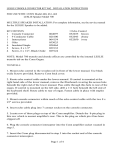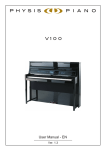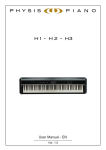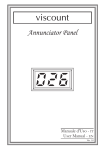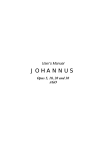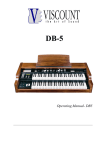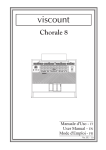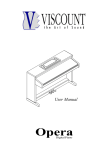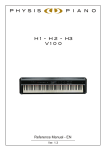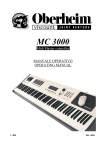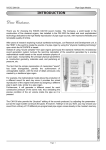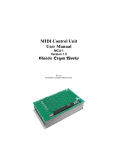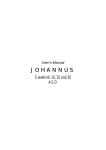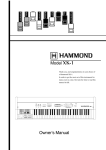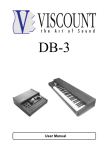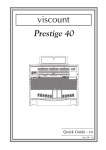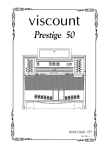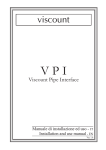Download Chorale8 USA (EN) v10
Transcript
viscount Chorale 8 User Manual Ver. USA - 1.0 Owner’s Manual Viscount Chorale 8 INDEX 1. Important notes ..................................................................................................................................3 1.1 Looking after the product ...............................................................................................................3 1.2 Notes about the manual ..................................................................................................................3 2. Controls and connection ....................................................................................................................5 2.1 The front panel ...............................................................................................................................5 2.2 The manual splitter controls ...........................................................................................................6 2.3 The side panels ...............................................................................................................................8 2.4 Pedal board controls .....................................................................................................................10 2.5 The connections underneath the manuals ......................................................................................... 11 2.6 The connections on the rear panel ...................................................................................................12 3. Main control unit ...............................................................................................................................13 3.1 Switching on and main video page ...................................................................................................13 3.2 An introduction to the instrument’s setup functions ...........................................................................15 4. Regulation the section volumes ........................................................................................................17 5. Organ Style ........................................................................................................................................17 6. Replacing voices and regulating voices volumes .............................................................................18 6.1 Regulating the voices volumes .........................................................................................................19 6.2 Replacing voices .............................................................................................................................20 7. Instrument general settings ..............................................................................................................22 7.1 Setting the tremolo ..........................................................................................................................23 7.2 Selecting the type of reverb .............................................................................................................23 7.3 Equalizers adjustment .....................................................................................................................25 7.4 Signal routing on the audio outputs ..................................................................................................26 7.5 Regulating the audio output volumes ................................................................................................26 7.6 General manual settings ...................................................................................................................27 7.7 Piston settings .................................................................................................................................28 7.8 Combination saving settings ............................................................................................................29 8. MIDI ..................................................................................................................................................30 8.1 Selecting the channels .....................................................................................................................32 8.2 Program Change message transmission ...........................................................................................32 8.3 Setting the filters .............................................................................................................................33 9. Utility functions ..................................................................................................................................34 9.1 Style copy ......................................................................................................................................34 9.2 Factory Setting ...............................................................................................................................35 9.3 Accessiong the modification functions ..............................................................................................36 10. Appendix ...........................................................................................................................................37 10.1 Demonstration songs ....................................................................................................................37 10.2 Voice Local Off ............................................................................................................................37 10.3 Upgrading the operating system ....................................................................................................38 1 Owner’s Manual Viscount Chorale 8 2 Owner’s Manual Viscount Chorale 8 1. IMPORTANT NOTES 1.1 LOOKING AFTER THE PRODUCT • Do not apply excessive force to the organ’s structures or the controls (knobs, stops, push-buttons, etc.). • When possible, do not place the instrument close to units which generate strong interference, such as radios, TVs, computer videos, etc. • Do not place the organ close to heat sources, in damp or dusty places or in the vicinity of strong magnetic fields. • Do not expose the instrument to direct sunlight. • Never insert foreign bodies inside the instrument or pour liquids of any kind into it. • For cleaning, use only a soft brush or compressed air; never use detergents, solvents or alcohol. • Always use good quality screened cables for connection to amplification or diffusion systems. When disconnecting cables from sockets, always take hold of the connector and not the cable itself; when winding cables, do not knot or twist them. • Before making the connections ensure that the other units (especially amplification and diffusion systems) you are about to connect are switched off. This will prevent noisy or even dangerous signal peaks. • Connect the net cable to an earthed socket. • Check that the voltage corresponds to the voltage shown on the serial number plate of the organ. • If the organ is to be out of use for lengthy periods, disconnect the plug from the power socket. 1.2 NOTES ABOUT THE MANUAL • Take good care of this manual. • This manual is an integral part of the instrument. The descriptions and illustrations in this publication are not binding. • While the instrument’s essential characteristics remain the same, the manufacturer reserves the right to make any modifications to parts, details or accessories considered appropriate to improve the product or for requirements of a constructional or commercial nature, at any time and without undertaking to update this publication immediately. • All rights reserved; the reproduction of any part of this manual, in any form, without the manufacturer’s specific written permission is forbidden. 3 Owner’s Manual Viscount Chorale 8 • All the trademarks referred to in this manual are the property of the respective manufacturers. • Read all the information carefully in order to obtain the best performances from your product and waste no time. • The codes or numbers in square brackets ([]) indicate the names of the buttons, sliders, trimmers and connectors on the instrument. For example, [ENTER] refers to the ENTER button. • The illustrations and display pages are purely guideline and may differ from those actually shown on the display. • The instructions provided in this manual only concern the instrument's operating system version that was up to date when the document was released. Therefore, such instructions might not describe faithfully your current operating system release. Please, visit the website http://www.viscount.it to check for the newest manual. 4 Owner’s Manual Viscount Chorale 8 2. CONTROLS AND CONNECTIONS 2.1 THE FRONT PANEL The organ’s front panel above the three manuals contains the stop keys, arranged section by section, used to activate the registers, and the Crescendo LED bar. Each stop key may be marked with the name of more than one register, since the associated register may change depending on the organ style selected with the STYLE parameter on the display (see also chap. 5). 1 2 PEDAL Contra Violone 32’ Contra Bass Principal 16’ Sub Bass 16’ Violone Quintatone 16’ Octave 8’ Bass Flute 8’ Choral Bass 4’ SWELL Schalmei 4’ Mixture Flute 2’ Bombarde Fagotto 16’ Trumpet Dulcan 8’ Great to Pedal Swell to Pedal Choir to Pedal Bourdon 16’ Rohr Flute Diapason V.Humana Concert Fl. 8’ 8’ Gamba 8’ Celeste 8’ Prestant 4’ Open Flute Melodia 4’ Doublette Flautino 2’ 4 3 CRESCENDO Mixture V Fagotto Regal 16’ Trumpet 8’ Oboe Cor Anglais 8’ Clarion 4’ Tremolo 5 GREAT Violone Quintatone 16’ Open Diapason 8’ Bourdon 8’ Gemshorn Flute Trav. 8’ Unda Maris 8’ Octave 4’ Flute Harm. Rohr Flute 4’ Twelfth 2 2/3' Cornet CHOIR Fifteenth Wald Flute 2’ Mixture Larigot 2 2/3' Trumpet Oboe Honrn 8’ Tremolo Swell to Great Choir to Great Hohl Flute Gedackt 8’ Dulciana Quintaton 8’ Gemshorn Flute 4’ Nazard 2 2/3' Piccolo Principal 2’ Tierce 1 3/5' Mixtur 4 f. Mixture Sifflet 1’ V.Hum. 8’ Tremolo Swell to Choir 1. [PEDAL] section: this section contains the pedal board register stops. The following couplers are also provided: o [Great to Pedal]: the stops of the Great will also play on the pedal board. o [Swell to Pedal]: the stops of the Swell will also play on the pedal board. o [Choir to Pedal]: the stops of the Choir will also play on the pedal board. 2. [SWELL] section: Swell stops and tremolo. 3. [CRESCENDO] LED bar: displays the steps of the Crescendo currently set with the pedal of the same name. 4. [GREAT] section: Great stops, tremolo and couplers: o [Swell to Great]: the stops of the Swell will also play on the Great. o [Choir to Great]: the stops of the Choir will also play on the Great. 5. [CHOIR] section: contains the stops and tremolo of the Choir and the coupler: o [Swell to Choir]: the stops of the Swell will also play on the Choir. 5 Owner’s Manual Viscount Chorale 8 2.2 THE MANUAL SPLITTER CONTROLS The pistons used to recall the adjustable combinations, Tutti, couplers and other accessory functions are placed in the areas between the manuals. 1 S 3 4B 4A 2A 5 9 10 HR 1 2 3 4 5 6 SW/P HR 1 2 3 4 5 6 PREV NEXT MIDI SW SWS VOL. MENU 12 HR 1 2 3 4 5 6 G/P HR 1 2 3 4 5 6 SW/G C/G MIDI G MIDI P A.P T 13 C/P HR 1 2 3 4 5 6 SW/C C 14 viscount 2D 4C 2B 2C 7 MIDI C 6 8 11 1. General combinations: this section contains the instrument’s general adjustable combinations. When a combination is recalled, the light of the relative stop illuminates to confirm its activation. The [NEXT] pistons can also be used to select combinations one by one in an upward direction and [PREV.] for the same function in a downward direction (combination sequencers). 2. Division combinations: this organ has six adjustable division combinations for Swell (2A), Great (2B), Choir (2C) and the pedal board (2D). When a combination is recalled, the light of the relative piston illuminates to confirm its activation. In division combinations, the user is only able to set the configuration of the section associated to the selected combination. There is also a piston marked [HR] (Handle Registers) beside the general and dedicated combinations; also known as 0, when it is on it automatically memorises the register status. This piston’s main function is to restore, during use of the combinations, the “hand-made” stop setup created when the [HR] button was on. Remember that an HR setup is not modified if the stops are switched on and off by hand when a combination on the same section is selected (i.e. with the HR off). N.B. The contents of the HR are not retained when the organ is switched off. Each combination (including HR and Tutti), whether general or sectional, is able to store: - the status (on/off) of the stops - the status of the couplers (enabling saving, see point 7.8) - the status of the tremolos (even with different modulation depths and speeds, if the specific SET-UP menu function described in par. 7.8 is activated) - the style (Organ Style) - the MIDI controls (point 8) and the Program Changes set using the SEND PROGRAM CHANGE function (par. 8.2) 6 Owner’s Manual Viscount Chorale 8 The All Swells to Swell pedal and Automatic Pedal can also be saved in the general memories and HR and in the Tutti only, by activating the specific function, see par. 7.8. For the fixing combinations procedure, see point 3. 3. [S] piston: “Set” (or fix) function used for fixing combinations. To fix a combination, simply press the [S] piston, keep it pressed and then press the combination you wish to fix, which may be dedicated, general or Tutti. WARNING! The [S] piston displays the on-off status for enabling of setting of the combinations, the Tutti and the Crescendo setups, and access to the organ’s setup (LOCK ORGAN function, see point 9.3). When the light in the piston is on, the functions listed above are enabled; when the light is off, the organ’s sound setup cannot be modified, and only the parameters shown in the main screen can be edited. 4. Pistons [P]: these pistons activate the couplings of the manuals with the pedal board, as follows: o [SW/P] (4A): coupling of the Swell with the pedal board o [G/P] (4B): coupling of the Great with the pedal board o [C/P] (4C): coupling of the Choir with the pedal board 5. [NEXT] and [PREV.] stops: general combination sequencers. [NEXT] selects combinations in ascending order, [PREV.] in descending order. 6. Great couplers: these pistons control the status of the Great couplings, as follows: o [SW/G]: coupler of the Swell to the Great o [C/G]: coupler of the Choir to the Great 7. [SW/C] Piston: activates coupling of the Swell to the Choir. 8. [MIDI C], [MIDI G], [MIDI P] and [MIDI SW] pistons: this section contains the pistons used to activate the transmission of MIDI note codes on the [MIDI OUT] port (in the recess on the left underneath the Choir) in response to the notes played on the manuals. The LED of each piston displays the status of transmission on the manual’s MIDI channel as follows: o Piston illuminated: note code transmission enabled o Piston off: note code transmission disabled N.B. - These pistons activate or deactivate the transmission of MIDI note codes (Note On and Note Off) only, unlike all the other MIDI messages the organ is able to process, which are always transmitted regardless of the status of this function. - These pistons control transmission of MIDI notes only. Reception is always enabled. 7 Owner’s Manual Viscount Chorale 8 9. [SWS] piston: pressing this piston activates the “All Swells to Swell pedal” function used to control the organ’s general volume using the swell pedal [SWELL]. N.B. When the Enclosed function is activated, the volumes of all manuals are immediately set in relation to the position of the [SWELL] swell pedal. When the Enclosed function is deactivated, the volume of the Choir is immediately readjusted in relation to the position of the [CHOIR] swell pedal, while those of the pedal board and Great are set in accordance with the setting in the VOLUMES function (see chap. 4). 10. [VOL.] piston: used to display the divisional volumes of each section of the organ. 11. [A.P.] piston: this piston controls the status of the Automatic Pedal function used to play the stops of the pedal board using the first 32 notes of Great. In this case, the organ’s pedal board is deactivated and the stops become monophonic, with priority to the lowest note. 12. [MENU] piston: used to display the organ setup functions menu. 13. [T] piston: piston used for switching the Tutti on and off. The voice composition of the Tutti function is programmable. To set a new configuration, switch on the stops and couplers of your choice, press [S], keep it pressed and then press the [T] piston or the [TUTTI] foot piston. 14. [C] piston: Cancel piston, which switches off all the stops, tremolos, couplers and pistons on any manual divisions active, then resets the general and dedicated HRs. 2.3 THE SIDE PANELS Other organ controls such as the volume controls, reverb adjustment and the graphic display showing all the instrument’s main setup and adjustment functions are located on the right and left of the manuals, in easy reach of the organist. To make use of these controls quicker and easier, all the rotary trimmers and the Orchestra voices are on the left of the manuals, with the graphic display and the relative control buttons on the right. LEFT PANEL 1. [ORCHESTRA] Registers: contains the registers of the Orchestra voices for the four sections of the organ. ORCHESTRA Pedal String Custom 1 Swell Celesta Custom Great Chime Custom Choir Harp Custom 3 POWER EXT. SPK. MASTER VOL. 2 4 REVERB VOL. 5 2. [POWER] Switch: the switch used to switch the organ on and off. 3. [MASTER VOL.] trimmer: regulates the organ’s general volume. 8 Owner’s Manual Viscount Chorale 8 4. [REVERB VOL.] trimmer: regulates the level of the reverb digital effects. 5. [EXT.SPK] Switch: on-off switch for loudspeakers (if any) connected to the outputs on the rear panel, powered by means of the [EXT. +12V DC] socket. WARNING! Do not switch the organ on and off in rapid succession. After the instrument is switched off, wait at least 10 seconds before switching it back on. RIGHT PANEL 1. Display: graphic display of 128x64 pixels for display of all the screens relating to the organ’s functions. 2. [FIELD S] and [FIELD T] buttons: buttons used to move the cursor around within the display screens. The [FIELD S] button moves the cursor to the field above (the one currently selected) while [FIELD T] selects the field below. 3. [VALUE +] and [VALUE -] buttons: buttons for adjusting parameters. [VALUE +] increases the value, [VALUE -] decreases it. 4. [EXIT] and [ENTER] buttons: buttons for accessing or exiting menu screens. [ENTER] is used to enter the menu or function shown on the display or confirm any prompts from the system. [EXIT] is used to exit the screen on the display and return to the previous one, or abort any prompts from the system. 9 1 FIELD + VALUE ENTER FIELD VALUE EXIT 2 4 3 Owner’s Manual Viscount Chorale 8 2.4 PEDAL BOARD CONTROLS The bottom part of the organ, above the pedal board, contains the swell pedals and a number of foot pistons for controlling the couplers, the Plenum and Reeds functions and the Tutti. 8 CHOIR SWELL CRESCENDO GT/PD SW/PD CHR/PD SW/GT TUTTI CHR/GT REED SW/CHR 1 PLENUM 2 3 4 5 6 7 1. Coupler pistons: these pistons activate the organ couplings described in par. 2.1 (point 1 e 2). 2. [CHOIR] Swell Pedal: swell pedal used to regulate the volume of the Choir. 3. [SWELL] Swell Pedal: this swell pedal is used to regulate the volume of the Swell. 4. [CRESCENDO] pedal: you can use this pedal to select the Crescendo steps which activate a preset series of stops. The step currently selected is displayed by the [CRESCENDO] LED bar on the central panel (see also point 2.1, subsection 3). Each Crescendo step is programmable. To do this, use the [CRESCENDO] pedal to select the step you require, switch on the voices and couplers of your choice, press [S], keep it pressed and then press the general memories [HR] button. 5. [PLENUM] piston: piston which activates the Plenum, which will be added to the existing sound setup. 6. [REEDS] piston: piston which activates the reed registers, which will be added to the existing sound setup. The sound compositions of the Plenum and Reed functions are programmable. To save a new configuration, switch on the registers of your choice, press the [S] piston, keep it pressed and then press the [PLENUM] or [REEDS] piston. 7. [TUTTI] foot piston: piston used to activate the Tutti. For a more detailed description, refer to point 13 of section 2.2. 8. Sustain switch pedal: Sustain pedal to be used with the Orchestra voices. N.B. The display volume controls which can be displayed by pressing the [VOL.] button allow balancing of the sections; once you have set the levels best suited to your taste and the sound balance you require, they will not require frequent adjustment. The swell pedals, on the other hand, allow continuous control of the volumes, enabling you to obtain all the dynamic effects you wish. Apart from regulating the volume, the swell pedals also simulate the variation in timbre of the stops which would occur in the swell boxes of pipe organs. 10 Owner’s Manual Viscount Chorale 8 2.5 THE CONNECTIONS UNDERNEATH THE MANUALS In the left of the organ, under the surface which contains the manuals and side panels, there is a small recess containing various connectors for connecting the organ to remote sound and MIDI devices. 1 2 THRU HEADPHONES OUT MIDI 3 IN L(MONO) R INPUT 4 L(MONO) R OUTPUT 1. [HEADPHONES] connector: Jack socket to which a headphone set can be connected. With headphones connected, the organ’s internal amplification is cut off. N.B. To obtain the best results from the [HEADPHONES] output, phones with impedance of at least 16Ω should be used. 2. [MIDI] connectors: five-pin DIN connectors for connection of instruments with MIDI interface. The [IN] connector allows receipt of MIDI data generated by remote MIDI sources, the [OUT] connector transmits the MIDI messages generated by the Chorale 8, and the [THRU] connector transmits the MIDI data exactly as received at the [IN] connector. 3. [INPUT] connectors: RCA line inputs which allow other instruments to be played using the organ’s internal amplification. If the source is monophonic use the L(MONO) connector only. 4. [OUTPUT] connectors: RCA line outputs for the unamplified signal, for connection of optional amplified speakers, remote amplification systems or recording systems. To use a monophonic signal, connect to the [L/(MONO)] connector only. 11 Owner’s Manual Viscount Chorale 8 2.6 THE CONNECTIONS ON THE REAR PANEL In the bottom of the rear panel there are two more pairs of line audio outputs, an optional amplified stereo output, and the power supply socket for the connected loudspeakers. The main difference between these outputs and the ones in the recess underneath the manuals is that the latter contain the signal generated by the organ, while on the rear connectors, the signals of the individual manuals and pedal board are routed to and adjusted on the individual outputs in accordance with the relative settings on the display (for more information see points 7.3, 7.4 and 7.5). OPTIONAL EXT. +12V DC 300 mA L(+R) - + 1 R L(+R) AUX OUT 1 R AUX OUT 2 2 L R SPEAKER OUT 8 3 1. [EXT. +12V DC] connectors: these sockets can be used to obtain the +12V DC voltage needed to supply the VISCOUNT speakers connected to the [AUX OUT] outputs 2. [AUX OUT 1] and [AUX OUT 2] connectors: Jack line outputs carrying the organ signal in accordance with the routing set by means of the function on display. With the Factory Settings active, the signals are distributed as follows: - [AUX OUT 1]: General signal [AUX OUT 2]: Reverb only 3. [SPEAKER OUT] connectors: amplified stereo output to which a pair of passive loudspeakers can be connected. In Factory Setting mode, the amplified general organ signal can be obtained from these outputs. The optional internal amplifier must be installed to allow use of these outputs. Contact your dealer for more information. N.B. For installation, connection and setup of the internal amplifier refer to the installation guide in the optional’s packaging. 12 Owner’s Manual Viscount Chorale 8 3. MAIN CONTROL UNIT As described in the previous section, the right-hand panel beside the manuals contains the main control unit for all the Choral 8’s internal functions. The organ features a large set of control functions allowing the user to customise the instrument in the most suitable way, adapting it to his or her own requirements. These are not mere general settings, but setup functions that configure every part of the organ: for the sound setup, for example, the user can select the instrument’s musical style, or change the registers assigned to the stops and then regulate their individual volumes. The levels, equalisation and channel routing of the remote outputs can also be adjusted. The organ also allows complete, unrestricted configuration of the MIDI interface, as well as the familiar settings of the tremolo and reverb effects, the manuals and the pedal board, the internal graphic equalizer and the piston functions. 3.1 SWITCHING ON AND MAIN VIDEO PAGE When the organ is switched on using the [POWER] switch on the left-hand panel, the instrument becomes operational after a few seconds, during which time all the amplification circuits are activated and the internal systems are configured. While this is taking place, the display shows the introductory screen: on which the release of the firmware installed on the instrument can always be checked. After the switch-on procedure is complete, the main video page will be displayed: containing the following display fields: o MEMORY BANK: this parameter can be used to select one of the eight memory banks for saving the general and/or specific combinations. Therefore, as well as providing a total of 48 general and 192 dedicated combinations, this function is especially useful if the instrument is used by more than one organist, since each of them will be able to save his or her own programming settings in a different Memory Bank. o TRANSPOSER: key transposer with a range of +5 / -6 semitones (adjustments in steps of one semitone). 13 Owner’s Manual Viscount Chorale 8 o TEMP (Temperament): this parameter allows the selection of a series of historic temperaments of different eras and national origins. You can choose from EQUAL, a temperament with perfect tuning, or the classical KIRNBERGER, WERCKMEISTER, PYTHAGOREAN, MEANTONE and VALLOTTI temperaments. o ENSEMBLE: this parameter can be used to set six levels of natural tiny differences in pitch between one organ pipe and another, in order to simulate the tuning errors that occur in the organ’s pipes due to wear over time and variations in temperature. If you wish to use the registers perfectly tuned, select the – value. o STYLE: selection of the organ style required. For further information refer to chap. 5. HOW TO MOVE AROUND INSIDE THE SCREENS The screen cursor is in the form of the field displayed in reverse; in the screen shown above, for example, the cursor is located on the MEMORY BANK parameter. As explained in paragraph 2.3, to move the cursor use the [FIELD S] and [FIELD T] buttons. [FIELD S] moves the cursor to the field above, [FIELD T] locates it on the one below. If a menu consists of more than one screen, an arrow symbol indicating that previous and/or subsequent pages are available will appear in the top right-hand corner. there are pages after the one currently displayed there are pages before the one currently displayed there are pages before and after the one currently displayed To access a submenu or a function, press the [ENTER] key; to exit the current screen use the [EXIT] button. To adjust parameters or select the various settings / options, use the [VALUE +] and [VALUE -] buttons. A BRIEF NOTE ON TEMPERAMENTS In the “natural” tuning system, based on the acoustic phenomenon of harmonic sounds, two important musical intervals, the major third and the perfect fifth, cannot be made to coexist in the “pure” state (i.e. beat-free). Therefore, over the centuries a variety of compromise solutions known as TEMPERAMENTS have been invented and realised. These give priority to one or the other interval by modifying them in various ways. In the ancient world and the Middle Ages, until the last few decades of the 17th Century, the “Pythagorean” tuning system, in which the fifths were retained perfectly pure, was in use. The resulting major third was particularly unattractive in sound, and was therefore treated as a dissonance. However, the music of the time was mainly monodic, and the early forms of vocal and instrumental polyphony made a great deal of use of the interval of a fifth. With the early Renaissance, and the start of the great flowering of vocal polyphony, the interval of a major third gradually came to be heard as consonant and not dissonant. The instruments with fixed tuning, such as the organ and harpsichord, gradually adapted to this situation by adopting a system of temperament known as “Meantone”, which gave the major third priority over the fifth. This temperament is particularly important because it was the temperament in normal use in Europe in the 16th and 17th Centuries, until the early 18th Century. Here are the six temperaments available on the Chorale 8, first and foremost the MEANTONE. 14 Owner’s Manual Viscount Chorale 8 MEANTONE - 8 pure major thirds: E flat - G / B flat - D / F - A / C - E / G - B / D - F # / A - C# / E - G. - 4 unusable major thirds (diminished fourths): B - D# / F# - A# / C# - E# / A flat - C. - 1 fifth known as the “wolf” (very dissonant extended fifth): A flat - E flat. - Highly irregular chromatic scale (meaning that chromatic compositions are given a very distinctive voice) - Keys usable with this temperament: C maj. / D maj. / G maj. / A maj. / B flat maj. and the relative minors. The temperaments which follow allow all the major and minor keys to be used, although those with the most alterations have a highly distinctive voice, in contrast with the modern equal temperament. WERCKMEISTER This temperament, invented by the organist and musical theorist Andreas Werckmeister, is recommended for performing the German musical repertoire of the late 1600s. KIRNBERGER This temperament, developed by Johann Philipp Kirnberger, pupil of J.S. Bach, is also suitable for playing the German baroque composers and the works of Bach. PYTHAGOREAN In this temperament, all the fifths are natural except for the “wolf” fifth, in the interval A flat - E flat, which is greatly diminished. It dates from the Middle Ages up to the 15th century, and can therefore be used for compositions of that period. VALLOTTI This Italian temperament invented by Francescantonio Vallotti was later taken up in England by Thomas Young. It can be used effectively for the Italian 18th Century repertoire, and also for the English repertoire of the same period. 3.2 AN INTRODUCTION TO THE INSTRUMENT’S SETUP FUNCTIONS Pressing the [MENU] piston in the Swell panel accesses the menu containing all the organ’s setup functions. The first video page displayed is as follows: scroll the cursor downwards using the [FIELD T] button to display the second part of the menu: The display options are: o VOICES: setup functions for all the organ’s voices, such as loading of alternative voices and volume adjustment. 15 Owner’s Manual Viscount Chorale 8 o SETUP: this submenu contains all the organ’s general settings, such as adjustment of the tremolos and equalisers, selection of the type of reverb, adjustment of the real output signals, and setup of the manuals and the pistons on the section control boards. o MIDI: setup of the organ’s MIDI interface. o UTILITY: utility functions such as adjustment of the instrument’s fine tuning, display contrast, copies the styles, recall of the Factory Settings and controls access to the modification functions. o DEMO SONG: collection of a number of demonstration tracks. To access the submenu of your choice, select the relative display field using the [FIELD S] and [FIELD T] buttons and press [ENTER]. Use the [EXIT] button to return to the main video page. For a clearer view of the various submenus, the table below summarises the way in which all the organ’s functions are organised. MENU SETTING VOICES MIDI Voices Volume Pedal Voices Volume Choir Voices Volume Great Voices Volume Swell Voices Volume TX/RX Channel Pedal channel setting Choir channel setting Great channel setting Swell channel setting Alternative Voices Pedal Alternative Voices Choir Alternative Voices Great Alternative Voices Swell Alternative Voices Send Program Change Pedal PG setting Choir PG setting Great PG setting Swell PG setting SETUP TX/RX Filter Control Change filter setting Program Change filter setting Sys-Ex filter setting Real-Time filter setting Tremolo Tremolo setting Reverberation Reverberation Type UTILITY Equalizer Internal Equalizer setting Out1 & 2 Equalizer setting Speaker Out Equalizer setting (optional) External Out Router External Out Router setting Tuning setting LCD contrast setting Style Copy function Factory Setting Lock Organ setting DEMO Demo song selection External Out Volume External Out Volume setting Keyboard Setting Choir/Great Keyboards Inversion setting Key Velocity setting Pistons Setting Great/Pedal Piston Combine setting Prev./Next Pistons Action setting Function Stored into Piston Tremulant Depth and Speed setting SWS and A.P. setting Couplers setting 16 Owner’s Manual Viscount Chorale 8 4. REGULATING THE SECTION VOLUMES Pressing the [VOL.] piston on the Swell panel displays the section volumes video page: Use the [FIELD S] and [FIELD T] buttons to move the cursor to the relevant section and [VALUE +] and [VALUE -] to adjust the volume as required. To confirm the changes and exit the video page, press the [EXIT] button. 5. ORGAN STYLE One important feature of the Chorale 8 series is the availability of four different organ styles, Baroque, French, English and American which allow you to set the sound configuration perfectly suited to the literature you intend to perform Since they have been programmed as appropriate to the different schools of organ building, these styles cannot be modified by the user. There are 4 additional User styles, which can be modified as required. Remember that the stop switches on the front panel can contain more than one register each. This is because when different styles are selected, the registers assigned to the various stops may change. The names of the registers marked on the stops are the ones which will be recalled by the preset styles; however, the User styles may recall registers the names of which are not screen-printed on the stops if the user programmes them to do this. Each style automatically saves the modifications made to the sound setup using the voice replacement functions and voice volume adjustments. This means that each style can be modified and customised to personal taste, making the organ extremely flexible. When a specific basic setup is required during programming, the instrument also allows a style (which may be a fixed style) to be copied into another User style using the STYLE COPY function described in point 9.1. The video page used to select the organ style required is displayed a few moments after the organ is switched on. The style can be recalled using the STYLE parameter. Using the [VALUE +] and [VALUE -] buttons you can select the desired style. 17 Owner’s Manual Viscount Chorale 8 As described in the instruction to this section, it is important to remember that the Organ Styles save the status of the following functions: - ALTERNATIVE VOICE (voices assigned to each stop) VOICE VOLUME (volumes of the voices) REVERBERATION (type of reverb effect) INTERNAL EQUALIZER (equalizer for the internal amplification system) EXTERNAL EQUALIZER (equalizzatore per le uscite audio posteriori) The functions described above can only be modified when a User style has been selected. Since the Baroque, French, English and American styles cannot be edited, if the user attempts to modify these functions the display will show: 6. REPLACING VOICES AND REGULATING VOICE VOLUMES One important new feature of the Chorale 8 series is the capability for replacing the voices initially associated to the front panel stops with other voices already provided in the organ’s internal memory. In practice, this gives quick, easy voice replacement, which however enables you to set your organ’s entire sound setup exactly as you wish and at any time, with considerable advantages for the customisation of the instrument, and for its use by more than one organist (each of them will be able to have their own set of voices). The register setup can be further adjusted to individual requirements through regulation of the volume of each individual voice. All voice management functions can be recalled by selecting the VOICES after the [MENU] piston is pressed. The video page displayed is as follows: containing the following functions: o VOICES VOLUME: regulates the volume of the voices. o ALTERNATIVE VOICE: used to replace voices. To display the function required, select the relative display field using the [FIELD S] and [FIELD T] buttons and press [ENTER]. Use the [EXIT] button to return to the MENU video page. 18 Owner’s Manual Viscount Chorale 8 6.1 REGULATING THE VOICE VOLUMES The VOICES VOLUME function allows you to adjust the volume of each individual voice in a range from -9 dB to +9 dB. Each modification is saved immediately and is audible in real time, making it easier for the user to obtain the setting required. You must also remember that the voice volumes are saved by the organ styles, so when a style change is made, apart from possible replacements of the stop voices, the volumes will also be reconfigured to suit the selected style. However, changes made to the volumes are not lost when different styles are recalled and they are retained in the memory within the style. To recall this function, select the VOICES VOLUME option from the SETTING MENU; the display will show: containing the organ’s four sections. Then select the division where the voice for which you wish to adjust the volume is located or press for some seconds its tab insert (on the front panel): In the first example the display will show the first 4 voices of each section. In case this procedure is done through the tab insert il will immediately show the volume of the voice. In both cases, use buttons [FIELD S] and [FIELD T] for having on the display the volume of another voice. To regulate the volume, use the [VALUE +] and [VALUE -] buttons. The new value is rendered audible immediately and saved; press [EXIT] to return to the previous screen. IMPORTANT NOTES - The volumes of the individual voices are automatically saved in the current Organ Style (see also section 5). This means that when another style is recalled, the volumes will be reset to the values described in the last style recalled. When the style in which the voice volumes were changed is reloaded, the volumes will be reset to the latest adjustments. - To restore the original volumes of all the styles, recall the FACTORY SETTING function described in point 9.2. 19 Owner’s Manual Viscount Chorale 8 6.2 REPLACING VOICES As described at the start of this section, the Chorale 8 has an interesting, useful voice replacement function. The organ has a vast internal library of voices, comprising various variations on the original voices. To recall this function, select the ALTERNATIVE VOICE option from the VOICES submenu; the display will show the first screen: in which you have to select the section of the organ containing the stop of the voice to be replaced, or press the stop itself on the front panel (as if to switch it on). In the first case the display shows the first four voices in the section selected. while if you hold pressed the stop the display immediately shows the screen shown below. Now use the [FIELD S] and [FIELD T] buttons to select the voice you wish to replace. After locating the cursor on the voice concerned, press [ENTER]. The top of the display contains information concerning the voice you are about to replace, while the central part of the screen shows the possible replacement registers for that specific stop. Here again, you can use the [FIELD S] and [FIELD T] buttons to scroll through all the replacement voices, which are rendered audible immediately for quicker programming by just moving the cursor over the fields of the voices displayed. Once you have found the voice you require, press [ENTER]: 20 Owner’s Manual Viscount Chorale 8 the system now provides information about the voice to be replaced (in the top of the screen) and the new voice (in the middle), and a prompt for confirmation to proceed, since the new register has not yet been definitively loaded, but has simply been rendered audible for evaluation. As the display shows, press [ENTER] to confirm the replacement or [EXIT] to abort. If you now go ahead with the operation, the system will definitively replace the old voice and give confirmation with the following screen: IMPORTANT NOTES - The voices for loaded for each stop are automatically saved in the current Organ Style (see also section 5). This means that when another style is recalled, the voices will be reset to the last style recalled. When the style in which the voices were changed is reloaded, the voices will be reset to the latest adjustments. - When a replacement voice is loaded, it will be assigned the volume value set for the voice present on the relative stop before the change was made. - To restore the original voices of all styles, recall the FACTORY SETTING function described in point 9.2. 21 Owner’s Manual Viscount Chorale 8 7. INSTRUMENT GENERAL SETTINGS All the organ’s general setup functions, i.e. the settings not strictly linked to the voices or the MIDI interface, are found in the SET UP submenu recalled by selecting the field of the same name on the display in the MENU. The first video page displayed is as follows: Since there are a large number of settings, the menu is displayed on two screens. Scroll the cursor downwards to display the other functions in the list: The following is a short description of the various settings: o TREMOLO: setting of the Tremolos for each manual. o REVERBERATION: selection of the type of reverb required. o EQUALIZER: for the equalizers adjustment. o EXT. OUT ROUTER: routing of the manuals and pedal board on the audio outputs [AUX OUT 1], [AUX OUT 2] and [SPEAKER OUT] (optional). o EXT. OUT VOLUME: regulates the volume of the audio outputs. o KEYBOARD SETTING: manual operation settings. o PISTONS SETTING: operation of the pistons on the section control boards. o FUNCTION STORED: combination fixing settings. As usual, use the [FIELD S] and [FIELD T] buttons to move the cursor and [ENTER] to display the screens of the functions required. Press [EXIT] to return to the MENU. 22 Owner’s Manual Viscount Chorale 8 7.1 SETTING THE TREMOLO In pipe organs, it is of fundamental importance for the air pressure to be constant in order to obtain an even, “sustained” sound. However, a number of mechanical devices were introduced to generate a number of periodic variations of varying intensity in the air flow. These variations produced a “tremulant” effect on the sound, which made a number of solo stops (such as the Vox Humana) more pleasant on the ear, and gave added expression to the reed stops. This effect can be enabled and disabled using the [TREMOLO] stops. The TREMOLO function can be used to set the speed and modulation depth of the tremolos for each manual. After the TREMOLO field is selected in the SET UP menu, the display will show the video page: containing the current values of the DEPTH (modulation depth) and SPEED (modulation speed) parameters of the tremulants of the three manuals. Then press [EXIT] to return to display of the SET UP menu and save the new settings. N.B. The Depth and Speed parameters can be saved with different values in each general and specific combination and in the Tutti. To do this, saving must be enabled using the Function Stored function described in point 7.9. 7.2 SELECTING THE TYPE OF REVERB Reverberation is the result of a series of sound reflections propagated inside an enclosed environment. The order and value of each reflection depend to a very great extent on an a large number of factors which come into play within any one room, such as the size of the room in which the phenomenon takes place, the nature of the materials of which it is made and the objects it contains, the listener’s position, etc. The digital signal processors incorporated in the Chorale 8 organs are able to artificially re-create the complex reverberations that naturally occur in the types of building where pipe organs are normally installed, and thus generate the right reverb effect to complete the instruments’ excellent timbre qualities. The purpose of the REVERBERATION TYPE function in the SET UP menu is to allow you to select the type of reverb effect, ranging from a large church with strong reverb and many sound reflections to a small room with short, muffled reverb. You may use this function to select eight different types of reverb effect. You can then use the [REVERB] trimmer in the left-hand control panel to regulate the level of reverb effect required. 23 Owner’s Manual Viscount Chorale 8 To select the reverb required, select the REVERBERATION field in the SET UP menu and press [ENTER]: The types available are: o CATHEDRAL: reverb typical of a cathedral o BASILICA: reverb typical of a basilica o GOTHIC CHURCH: reverb typical of a Gothic church o BAROQUE CHURCH: reverb typical of a Baroque church o ROMANIC CHURCH: reverb typical of a Romanesque church o MODERN CHURCH: reverb typical of a modern church o PARISH: reverb typical of a church hall o CAPPELLA: reverb typical of a chapel Use the [VALUE +] and [VALUE -] buttons to select the type of reverb and press [EXIT] to save the selection and return to display of the SET UP menu. N.B. - The organ’s internal reverb also affects the input signals reaching the [INPUT] connectors underneath the manuals. - The Organ Styles save the type of reverb. This means that organ styles with different types of reverb may be available, and that when a different style is recalled the reverb may be modified. 24 Owner’s Manual Viscount Chorale 8 7.3 EQUALIZERS ADJUSTMENT Your Chorale 8 organ is equipped with two 5-band graphic equalizers for the sound control. There is one equalizer for controlling the signal to the internal loudspeakers. A second equaliser is assigned to the signals sent to the [AUX OUT 1] and [AUX OUT 2] audio outputs, and a third to the [SPEAKER OUT] (optional) amplified output. In order to display these adjustments, select EQUALIZER and press [ENTER]. o INT. EQUALIZER: this displays the internal equalizer o EXT. EQUALIZER: this displays the audio outputs equalizer As you can see the following parameters appear on the right of the screen: o FREQ: central trigger frequency. o GAIN: gain of the signals with frequencies close to that stated in the FREQ parameter. The [FIELD S] e [FIELD T] buttons can be used to select the trigger frequency; then use the [VALUE +] and [VALUE -] buttons to regulate the attenuation (negative values) or enhancement (positive values) of the signal in a range of +/- 9 dB. A graphic indication of the equalizer is also displayed on the right of the screen, in real time. Here again, after making the settings you require, press the [EXIT] button to save the modifications and return to display of the SET UP menu. NOTES - The external equalizer settings also affect the signals supplied to the RCA [OUTPUT] outputs in the recess underneath the manuals. - The equalizers adjustment settings are also stored in the Organ Style. This means that organ styles with different types of external equalization may be available, and that when a different style is recalled the equalizer may be modified. 25 Owner’s Manual Viscount Chorale 8 7.4 SIGNAL ROUTING ON THE AUDIO OUTPUTS Another useful setting available on the Chorale 8 is the option of sending the signals of the individual manuals and pedal board to one audio output or both. This allows you to simulate location of the windchests in different positions by allocating the external speakers as required. To display the setting video page, select the EXT. OUT ROUTER field in the SET UP menu: The screen shows the two audio outputs, OUT1 ([AUX OUT 1]) and OUT2 ([AUX OUT 2]). You can set the signal source section for each output, as follows: o o o o o o o o PEDAL+GREAT GREAT SWELL PEDAL + GREAT + CHOIR PEDAL + GREAT + SWELL CHOIR + SWELL GENERAL (OUT1 only) REVERB ONLY (OUT2 only) As usual, use the [FIELD S ] and [FIELD T ] buttons to move the cursor and [VALUE +] and [VALUE -] to adjust the values. To conclude, press [EXIT] to save the new settings and return to the SET UP menu. 7.5 REGULATING THE AUDIO OUTPUT VOLUMES Another setting function available for the audio outputs is adjustment of the volumes of the individual outputs. To make the settings, select the EXT. OUT VOLUME field in the SETUP menu; the display shows the screen: containing the following parameters: o OUT 1: volume of output [AUX OUT 1]. o OUT 2: volume of output [AUX OUT 2]. 26 Owner’s Manual Viscount Chorale 8 All the levels can be set in a range of values from 1 to 32, with the following relative dB: - 32: 0 dB 20: -12 dB 16: -16 dB 10: -22 dB 1: -31 dB Naturally, intermediate signal level values will be obtained when values between these settings are shown on the display. NOTE The rear output volume settings also affect the signals supplied to the RCA [OUTPUT] outputs in the recess underneath the manuals. 7.6 GENERAL MANUAL SETTINGS The KEYBOARD SETTING function, recalled using the option of the same name in the SET UP menu, contains two different parameter relating to operation of the organ manuals. The video page displayed is as follows: containing the following display options: o CH/GT INVERS.: inversion of the manuals, so that the Choir registers are played with the Great and vice-versa. o KEY VELOCITY: activates the manual key dynamics. When this function is active, you can play the Orchestral voices and transmit the MIDI notes in response to the speed at which the manual keys are pressed. If the function is turned off, the notes are always played with fixed dynamic equal to the MIDI value 100. To activate the two functions, use the [VALUE +] and [VALUE -] buttons to select the value YES, or select NO to deactivate them. Use the [FIELD S] and [FIELD T] buttons to move the cursor and [EXIT] to save the new settings and return to the SET UP menu. 27 Owner’s Manual Viscount Chorale 8 7.7 PISTON SETTINGS The Chorale 8 setup procedure allows you to set the function of sector combination pistons and the pistons used for sequential recall of the general combinations [PREV.] and [NEXT]. To set these functions, select the PISTONS SETTINGS field in the SET UP menu; the display shows the screen: In this first screen you may activate or deactivate the Piston Combine function which allows the combinations of the Great to be “coupled” to those of the pedal board. This means that when a Great combination is recalled, the same combination will also be automatically activated for the pedal board. To activate the function, use the [VALUE +] and [VALUE -] buttons to select the value YES, or select NO to deactivate it. Now press the [FIELD T] button to display the second PISTONS SETTING function, relating to the function of the [PREV.] and [NEXT] pistons: If GENERAL MEMORY is selected the pistons operate like ordinary sequencers, recalling the individual general combinations in ascending or descending order. If MEMORY BANK is set, sequential selection no longer occurs on the combinations but on the memory banks (MEMORY BANK option in the main screen). [NEXT] therefore selects the memory banks in ascending order, [PREV.] in descending order. Once you have set the two functions as you require, press [EXIT] to return to display of the SET UP menu. 28 Owner’s Manual Viscount Chorale 8 7.8 COMBINATION SAVING SETTINGS The FUNCTION STORED INTO PISTONS function in the SET UP menu allows you to choose what you wish to save in the general and specific combinations and the Tutti in order to further customise the organ’s performance features. After the FUNCTION STORED field is selected in the SETUP menu, the display will show: This screen allows you to enable and disable saving of the Tremolo Depth and Speed values, so that you can obtain Tremolo of different modulation depth and speed by recalling the various combinations. Use the [VALUE +] and [VALUE -] buttons to select YES to enable saving or NO to disable it. Now press the [FIELD T] button to display the second saving setting screen: in which you can decide whether or not to save the status of the All Swells to Swell pedal and the Automatic Pedal. Here again, set YES to enable saving or NO to disable it. Press [FIELD T] again to display the last setting, used to enable or disable saving of the couplers in the divisional combinations. Finally, press [EXIT] to save the changes made and return to display of the SET UP menu. 29 Owner’s Manual Viscount Chorale 8 8. MIDI WHAT MIDI IS The MIDI interface (Musical Instrument Digital Interface) allows instruments of different makes and kinds to communicate with each other, using this very specific protocol of codes. This allows the creation of systems of MIDI instruments, offering much greater versatility and control than is possible with single instruments. To make this communication possible, all MIDI instruments have two or three 5-pin DIN connectors called: - MIDI IN: The connector through which the instrument receives the MIDI data transmitted by other units. MIDI OUT: The connector through which the instrument sends the MIDI data it has generated to other units. MIDI THRU: This connector, not always provided on all instruments, is used for connecting several units in series, since it transmits the MIDI data exactly as they are received by the respective MIDI IN port. Most instruments equipped with MIDI interface transmit MIDI messages which specify, for example, which note has been played and with what dynamic, by means of the MIDI OUT connector. If this connector is connected to the MIDI IN connector of another MIDI instrument, such as an expander, the second instrument will respond exactly to the notes played on the transmitter instrument. The same type of information transfer is used for recording MIDI sequences. A computer or a sequencer can be used to record the MIDI data generated by the transmitter instrument. If these recorded data are sent back to the instrument, it automatically repeats the recorded performance. MIDI is able to transmit a multitude of digital data by means of just one cable, and thus just one connector. this is thanks to the MIDI channels. There are 16 MIDI channels, and in a similar way as for radio communications in which two stations can only communicate if they are tuned to the same frequency (or channel), two MIDI instruments connected together are only able to communicate if the transmitter instrument channel is the same as the receiver instrument channel. MIDI messages subdivide into channel messages and system messages. The following is a short description of these messages: CHANNEL MESSAGES NOTE ON This message is transmitted when a note is depressed on the keyboard. Each Note On message contains the following information: Note On: when a key has been struck; Note Number: the key which has been pressed, and therefore the relative note played; Velocity: note dynamic (i.e. the force applied when the key was struck). Note messages are expressed as a number from 0 to 127, with middle C represented by number 60. NOTE OFF This message is transmitted when a key struck previously is released. When it is received, the sound of the note relating to the key is switched off. Each Note On message contains the following information: Note Off: a key has been released; Note Number: which key has been released; Velocity: dynamic (i.e. how fast the note was released). N.B.: A Note On message with Velocity=0 is considered equivalent to a Note Off message. The Chorale 8 sends the Note On message with Velocity=0. 30 Owner’s Manual Viscount Chorale 8 PROGRAM CHANGE This message is used to select the programs or sounds of the receiver instrument. There is also a specific standard called General MIDI which describes which sound should be recalled for each Program Change received. This association is usually described by means of a table included in the user manual of the instrument which adopts the standard. This message contains the following information: Program Change: voice or program change; Program Change Number: the number of the program or voice to be activated; CONTROL CHANGE These are control messages (often associated to trimmers or pedals) used to add expression to the performance, allowing you to set (and control in real time if necessary) voice parameters such as volume (CC n.7) or the position of the swell pedals (CC n.11), etc. This message contains the following information: Control Change: a controller has been adjusted Controller Number: which controller has been adjusted Controller Position: the position of the controller SYSTEM MESSAGES SYSTEM EXCLUSIVE These messages can only be interpreted by an instrument made by the same producer as the transmitter device (in some cases only by the same model). They mainly relate to the instrument’s sound generation and programming parameters. The Chorale 8 uses these messages to control all the internal parameters and for switching the voices on and off. REAL TIME These messages are used for the real-time control of specific modules or functions of a connected instrument. These messages include the Start, Stop, Pause/Continue and Clock commands. START: the sequencer has started to record or play back a MIDI sequence STOP: the sequencer has been stopped PAUSE / CONTINUE: the sequencer has been set in stop status CLOCK: the sequencer speed N.B. The Chorale 8 does not transmit / receive the messages described above. They are described for your information only. The Real Time messages also include the Active Sensing code, sent to keep the dialogue between two MIDI instruments alive. When the receiver instrument does not receive any MIDI data or the Active Sensing code in a time interval of about 300 milliseconds, it considers the MIDI connection to have been deactivated, so it switches off any notes still active. Remember that the transmission and reception of this message is optional, so not all instruments are equipped to handle it. To access all the Chorale 8 MIDI settings, select the MIDI option in the MENU screen and press [ENTER]. The functions available are as follows: o TX/RX CHANNEL: MIDI transmission and reception channel selection. o SEND PROG. CHANGE: Program Change message transmission. 31 Owner’s Manual Viscount Chorale 8 o TX/RX FILTER: MIDI filter setting. Use the [FIELD S] and [FIELD T] and [ENTER] buttons to select the function required. Otherwise, press [EXIT] to exit the MIDI submenu and return to display of the MENU screen. 8.1 SELECTING THE CHANNELS To set the MIDI transmission and reception channels, select the TX/RX CHANNEL field in the MIDI submenu: The four fields displayed correspond to the organ’s four sections. The number alongside identifies the transmission and reception channel for the section concerned. As usual, use the [FIELD S] and [FIELD T] buttons to locate the cursor on the display fields and [VALUE +] and [VALUE -] to select the channel required. Now press [EXIT] to return to the MIDI menu and save the settings made. N.B. - It is not possible to set different reception and transmission channels for the same section. - MIDI 16 channel cannot be selected since it is the system channel used for the exchange of internal codes between Viscount instruments. 8.2 PROGRAM CHANGE MESSAGE TRANSMISSION The MIDI Program Change (PG) message allows a specific sound or program (patch) to be recalled in a connected unit. Therefore, you can use this function to select the voice required from a remote module (such as an expander) connected to the [MIDI OUT] port directly from the organ itself. To display the relative video page, select the SEND PROG. CHANGE field in the MIDI menu and press [ENTER]: To transmit a PG message, locate the cursor on the section to which the MIDI channel of choice is associated and use the [VALUE +] and [VALUE -] buttons to set the number of the PG required. 32 Owner’s Manual Viscount Chorale 8 When each value is selected, the relative PG will be transmitted automatically. If, for example, the pedal board MIDI A channel is number 3, when 20 is selected beside the “PEDAL” field, Program Change n. 20 will be transmitted on the MIDI 3 channel. It is important to underline that the Program Changes set in this screen are saved in the specific and general combinations. To do this, simply select the PG messages in the screen described above and save the combination required. All this is particularly useful when you are using a remote expander, for example, and wish to obtain a specific voice in combination with the stops activated by means of the combination. If transmission of the PG is not necessary, saving of the PG can be aborted by selecting the value OFF. 8.3 SETTING THE FILTERS A MIDI filter is a special function which allows a specific message to be cut out on all the MIDI channels (if it is a channelled message) in transmission and/or reception. For example, the Control Change transmission filter allows you not to transmit these MIDI messages on the [MIDI OUT] port on all the MIDI channels controlled by the organ. Similarly, the reception filter cuts out the CCs received by the organ by means of the [MIDI IN] port on all the channels (i.e. the CCs are not applied). To set up the MIDI filters select the TX/RX FILTERS field in the MIDI submenu. The following screen appears: The filters for the following messages (shown in the top left-hand corner of the display) can be switched on and off: o o o o CC: Control Change (control messages) PG: Program Change (messages for selecting programs/voices) SYSEX System Exclusive (system exclusive messages) REAL: Real Time messages (Active Sensing). The right-hand side of the display contains the fields for the setting the filters for each type of message. The settings are: - NO/NO: both filters off. YES/NO: filter only active on messages transmitted NO/YES: filter only active on messages received YES/YES: filter active on both received and transmitted messages. When a filter is activated the relative MIDI message is not transmitted / received. Press [EXIT] to return to the MIDI menu and save the new settings. 33 Owner’s Manual Viscount Chorale 8 9. UTILITY FUNCTIONS The UTILITY submenu in the MENU contains the organ’s general utility functions. To display this menu, select the UTILITY option in the MENU screen and press [ENTER]. This submenu consists of two video pages, displayed using the [FIELD S] and [FIELD T] buttons: The fields displayed are: o TUNING: fine tuning of the instrument within a range of 415.3 Hz to 466.2 Hz (adjustments in steps of one tenth of a Hz). The frequency value refers to the third A. o CONTRAST: display contrast. o FACTORY SETTING: restores the factory settings. o LOCK ORGAN: organ lock function. 9.1 STYLE COPY The STYLE COPY function in the UTILITY submenu allows the contents of a style (i.e. the registers and their volumes, the reverb type and the equaliser settings) to be copied into another User style. This is particularly useful to avoid having to make settings which already exist, when the user wishes to programme a style starting from a preset style (Baroque, French, English or American) or a style programmed earlier (in another User style, for example). To recall this function, select the STYLE COPY option in the UTILITY video page; the display will show: In this video page, select the style you wish to copy by setting it in the SRC field, and the destination style in the DST field. As the display prompts, press [ENTER] to confirm the copy or EXIT to abort the function. 34 Owner’s Manual Viscount Chorale 8 Before making the copy, the system warns the user that the style shown on the display is about to be overwritten and its data will be irretrievably lost. Here again, press [ENTER] to continue or [EXIT] to abort the copy and return to the UTILITY submenu. 9.2 FACTORY SETTING The Factory Setting procedure allows you to restore the factory settings of all the instrument’s internal functions, deleting all the changes made by the user. To recall this function, use usual buttons to select the FACTORY SETTING option in the UTILITY submenu; the display will show: the system prompts you to confirm, warning that all the settings you have made will be irretrievably lost. To confirm the Factory Setting procedure press the [ENTER] key, or to abort the operation simply press [EXIT]. Once the Factory Setting operation has been started, the display will show a standby screen for the time taken to reload the factory data: after which the instrument will be rebooted automatically. 35 Owner’s Manual Viscount Chorale 8 9.3 ACCESSING THE MODIFICATION FUNCTIONS When the user considers it necessary to prevent modification of the organ’s setup, the LOCK ORGAN function can be used. This prevents modification of the combinations, Tutti and Crescendo steps, and the only video pages displayed will be the main and section volume pages. The light in the [S] piston goes out to indicate that the organ lock function is active. To do this, select the LOCK ORGAN option in the UTILITY and press [ENTER]: To release the lock and restore access to the functions described at the start of this section, press the [ENTER] button or the [MENU] piston. The display will prompt input of the password: As usual, use the [FIELD S] and [FIELD T] buttons to move the cursor and [VALUE +] and [VALUE -] to adjust the values, then [ENTER] to confirm. If the password is correct, the display will return to the UTILITY submenu; otherwise, the following video page will appear: stating that the password was incorrect and it must be entered again. 36 Owner’s Manual Viscount Chorale 8 10. APPENDIX 10.1 DEMONSTRATION SONGS The organ has a number of demonstration (demo) tracks to allow you to fully appreciate the quality its sound qualities and/or those of the changes you have made. To recall playback of the demo tracks, select the DEMO SONG option from the MENU screen. Use the [FIELD S] and [FIELD T] buttons to select each piece of music. Press [ENTER] to start and stop each piece. Press [EXIT] to leave the DEMO SONG function. 10.2 VOICE LOCAL OFF Setting a voice in Local Off mode means that it will not be played by the organ’s internal sound generation system, but the relative MIDI (System Exclusive) message will be transmitted, so that it can be turned on and played on a connected instrument. To set a voice Local Off press the [S] (Set) button, keep it pressed and also press the [C] (Cancel) button. All the draw-stops will come on and the display will show the video page: To set a voice in Local Off mode, press its draw-stop so that its light goes out. After setting the setup required, press [S] and [C] together to save it. Accessing the Local Off setting function after this will trigger display of the status of the voices as follows: - Light on: voice in Local On mode (plays with internal generation) Light off: voice in Local Off status During normal operation, when a voice in Local off mode is switched on, the draw-stop flashes three times then remains constantly lit. 37 Owner’s Manual Viscount Chorale 8 10.3 UPGRADING THE OPERATING SYSTEM Upgrading the organ’s operating system requires use of a MIDI file (extension .MID) reader, by means of which the data in the upgrade file can be transmitted to the organ. A hardware device used for MIDI sequencing, or a computer software package capable of processing this type of file, may be used. Connect the MIDI data output port of the transmitter device (which may be the MIDI OUT connector of a hardware module or of a serial or USB / MIDI interface or Joyport if a computer is used) to the [MIDI IN] connector of the Chorale 8. Start the updating procedure; when the organ starts to receive the data, the display will show : now the display will start to show a percentage of the data received. At the end of the procedure, the following video page is displayed: When the organ is switched on, if the display shows one of the following video page: If the display looks like the one shown on the left, you must turn the organ off and switch it back on whilst holding down the [FIELD S], [FIELD T] and [EXIT] buttons at the same time. You can then repeat the updating procedure. If the display looks like the one shown on the right it is possible to re-transmit the MIDI files straight away without having to manually recall the updating procedure. 38 MIDI IMPLEMENTATION CHART Viscount Chorale 8 Classic Organ Version: 1.0 Date: 28/09/2012 FUNCTION… TRANSMITTED BASIC Default 1÷15 CHANNEL Changed 1÷15 MODE Default Mode 3 ******** Messages ******** Altered NOTE 30÷101 NUMBER True Voice 36÷96 VELOCITY Note ON O X Note OFF AFTER Key's X TOUCH Ch's X PITCH BENDER X CONTROL 7 O CHANGE 11 O 64 O O 120 O 121 O 123 PROGRAM O CHANGE True# SYSTEM EXCLUSIVE O SYSTEM Song Pos X COMMON Song Sel X Tune X SYSTEM Clock X REAL TIME Commands X AUX Local On-Off X MESSAGES All notes off O O Active Sense X Reset NOTES: Mode 1: Omni On, Poly Mode 3: Omni Off, Poly RECEIVED 1÷15 1÷15 Mode 3 ******** ******** 0÷127 30÷101 O X X X X O O O O O O X Mode 2: Omni On, Mono Mode 4: Omni Off, Mono REMARKS Volume Expression Sustain All sound off Reset All Controllers All Notes Off O X X X X X X O O X O=YES X=NO Disposal of old Electrical & Electronic Equipment (Applìcable throughout the European Union and other European countries with separate collection programs) Dir. 2002/95/CE, 2002/96/CE e 2003/108/CE This syrnbol, found on your product or on its packaging, indicates that this product should not be treated as household waste when you wish to dispose of it. Instead, it should be handed overt to an applicable collection point for the recycling of electrical and electronic equipment. By ensuring this product is disposed of correctly, you will help prevent potential negative consequences to the environment and human health, which could otherwise be caused by inappropriate disposal of this product. The recycling of materials will help to conserve natural resources. For more detailed information about the recycling of this product, please contact your local city offi ce, waste disposal service or the retail store where you purchased this product. This product complies with the requirements of EMCD 2004/108/EC and LVD 2006/95/EC. FCC RULES NOTE: This equipment has been tested and found to comply with the limits for a Class B digital Device, persuant to Part 15 if the FCC Rules. These limits are designed to provide reasonable protection against harmful interference in a residential installation. This equipment generates, uses and can radiate radio frequency energy and, if not installed and used in accordance with the instruction, may cause harmful interference to radio comunications. However, there is no guarantee that the interference will not occur in a particular installation. If this equipment does cause harmful interference to radio or television reception, which can be determinated by turning the equipment off and on, the user is encuraged to try to correct the interference by one or more of the following measures: - Reorient or relocate the receiving antenna. Increase the separation between the equipment and receiver. Connect the equipment into an outlet on a circuit different from that to which the receiver is connected. Consult the dealer or an experienced Radio/Tv technician for help. The user is cautioned that any changes or modification not expressly approved by the party responsable for compliance could void the user’s authority opearate the equipment. INFORMATIONS FCC NOTE : Cet instrument a été controlé et il est garanti pour etre en conformité avec les spécifications techniques établies pour les dispositifs numériques de la « Classe B » selon les normes de protection contre les interférences avec d’autres dispositifs électroniques environnants. Cet appareil produit et utilise des fréquences radio. S’il n’est pas installé et utilisé selon les instructions contenues dans le mode d’emploi, il peut générer des interférences. L’observation des normes FCC ne garanti pas qu’il y aura aucune interférence. Si cet appareil est la cause d’ interférences avec une réception Radio ou TV, il est possible de le vérifier en éteignant puis en allumant l’instrument : Vous pouvez alors résoudre le problème en suivant les procédures suivantes : - déplacer ou orienter l’antenne de l’appareil avec lequel se manifeste l’interférence. déplacer cet instrument ou l’appareil avec lequel se produit l’interférence connecter cet instrument à une prise de courant différente afin de mettre les deux appareils sur deux circuits différents. consulter le revendeur ou un technicien radio/tv pour d’autres renseignements. D’éventuelles modifications non approuvées par le constructeur peuvent annuler votre garantie de l’appareil. viscount Viscount International S.p.A. Via Belvedere Fogliense 154 – 47836 Mondaino (RN), ITALY Tel: +39-0541-981700 Fax: +39-0541-981052 Website: www.viscount.it Distribuito in Italia da TITAN MUSIC S.A. Strada Genghe di Atto, 80 47892 Acquaviva - Repubblica di San Marino Tel. 0549-999164 fax 0549-999490












































